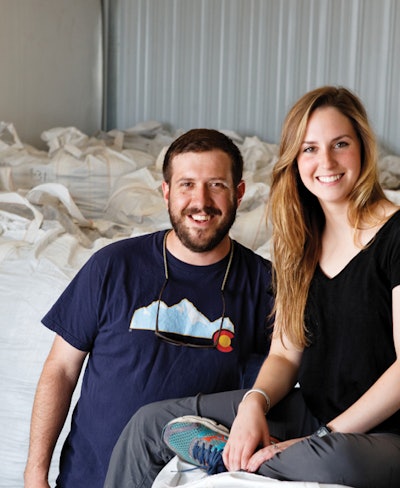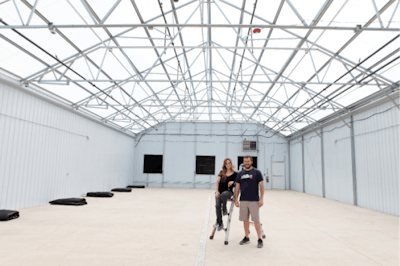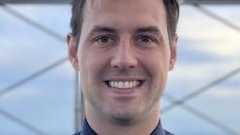
They built it from the ground up, designing a cannabis cultivation operation that was locally sourced and environmentally responsible to raise “naturally grown cannabis,” says Cohen.
Cannabis Business Times’ Managing Editor Kyle Brown talked with Brach and Cohen about how they planned the grows (30,000 square feet between a greenhouse and warehouse), and what it means to be aware of environment and community in the industry.
Kyle Brown: What were your first steps in getting the grow started?
Anthony Brach: It takes a strong group of diverse individuals with many different backgrounds. It has been a mix of people with … backgrounds in marketing and mergers and acquisitions and accounting. Even one of our guys is a compliance guy that trained in the medical scene. ... So Kelsey and I are … only responsible for the cultivation practices. It is a very compartmentalized group … and everybody is responsible for their own little piece of the puzzle.
We’ve seen where business owners think they can do it all. It really just doesn’t work that way because no one can do everything. You have to focus on ... your strengths … and realize what your weaknesses are. … Then hire or partner with people who are capable of doing things you aren’t.
Brown: How did you pull the team together?
Brach: That’s the crazy thing. Last summer when I was approached, they basically said, “We’ve got the whole team together, except for a grow team.” Finding … [people with] business management skills and marketing people, I mean, all of those jobs exist [from other industries]. But when it comes down to the basis of a cultivation site, you have to find … people ... [who are] able to talk business with business owners and also … able to grow [the] plant.
Brown: How did you plan the specs for the grow?
Kelsey Cohen: We learned a lot from old jobs and past experiences. We had just been … growing a list of … what would be helpful, what would be a dream to have and everything that would possibly be of a necessity to get this off the ground.
Brown: Did you actually make lists? What were the top items on those lists?
Cohen: Yeah, we did. [laughs] We didn’t know what it would entail for our budget with all of our wants. We also had to be realistic.
[At the top of the necessary list were] concrete floors for the greenhouse. We are very nervous with pests and disease … so we think concrete, avoiding having a dirty floor, would help mitigate that. Environmental controls were also high up there.
[For the dream list,] I would love to have an ATP assay tool. It’s a tool where you can swipe any surface, and it measures the ATP and the bacteria giving it off, so you know if your surface is contaminated or not. It’s actually a standard regulation in Canada.

Brown: What does it mean for you to be locally sourced?
Brach: We try to source everything ... first and foremost locally, which is the Western Slope. Then we [try to source within] Colorado, then we go to the western region of the United States. Then ... North America, then Central and South America. Then we start looking at seaport importation.
I would say 95 percent of the stuff we have bought is from North America.
Cohen: It is just a matter of being responsible and wanting to have a very low carbon footprint and be sustainable. …
Also, it pays … to have things locally, even if we have to pay a little bit more; if something were to break or happen, [the company] is right there.
Brach: You can buy fabric pots by the million and import [them] from China. But we paid for them to come from South Carolina, and manufactured in New Mexico. We paid an extra 50 cents per pot — times thousands of pots. But that is less carbon footprint on shipping, and … we are able to map out our sustainability ... and be responsible to the consumer. We are touting our sustainability and environmental stewardship.
Brown: What does “naturally grown cannabis” mean for you?
Cohen: No synthetic nutrients or pesticides. The term “pesticide” is actually really broad. ... We just use no synthetically based spray or pesticides. I would even like to use the word “organic,” but you’re not allowed to in this industry because it is a federal [U.S. Department of Agriculture] term. [But] … we are going for top-grade ingredients for consumers. We are putting in all-natural ingredients and trying to emulate Mother Nature. ... We are really trying to bring a higher standard.
Brach: Like [Kelsey] said, “pesticide” can be a pretty broad term. A pesticide is anything to combat or negate a pest or disease. That can be something as small as wiping tabletops down with a bleach solution or spraying a non-toxic type of essential oil on your plants to protect them. … That is emulating Mother Nature. …
So, in early plant processes, we spray a low dose of essential oils, which can be anything from rosemary to cinnamon, among others. These … occur in [nature] and are simply concentrated [into oils]. Then we put them into a spray and they basically bug the bugs, and the bugs don’t want to be on that plant.
It is a look at problems with prevention instead of solutions. They say “an ounce of prevention,” and it’s completely true in this regard. It’s just a matter of: Do you have the foresight to know what the potential problems are, and are you willing to spend the money up front to not have those problems?
Brown: How do you sell your investors on this?
Brach: The group was lucky enough to have a single-point investor (completely privatized financial backing) — a completely silent partner who, lucky for us, was raised here over on the Western Slope and had a family that has been in agriculture before. He … actually had a pretty basic understanding of agriculture and how hard the work is, and what is involved.
[The “selling”] was more on the lines of coming to the group and saying, “Here are all the preventative measures we can take, and this is how much it costs. Or here are all the reactionary methods and what they cost. But, the difference is that if we do the preventative measures, we don’t have to worry about a negative potential impact on our end product. Whereas, if we react to all of our problems, we are going to be squirming around, taking hits on our end product, taking hits on quality, putting way more labor and money into it.
Brown: What’s a hurdle that caught you off guard in putting the grow together?
Cohen: One of our main hurdles was the smell. People think that they will get high off the smell, whatever our building gives off – which is obviously not true. So, finding cost-efficient and effective smell mitigation was a challenge, especially to fit in with all of our ideals.
Brach: We found a solution, but it’s one of our proprietary solutions, and we are not at liberty to discuss what technology we use.
[A] major hurdle that no one has any control over, especially in Colorado, in the building process, is how adverse weather can affect your timeline for construction.
One of the [other] problems we have is the manufacturing end, and production of our greenhouse facility via [the company we hired], because they’re used to building a couple greenhouses a year. ... Then, boom, the cannabis industry hits, and they are under full demand, and they have not had a chance to increase their production warehouses and shipping routes.
So when they go to manufacture a specialized, high-tech greenhouse, it takes a lot of effort. And then they have dates that don’t necessarily line up. If you have a good project manager, he has a chart of when everything needs to arrive and ... get done. …
One or two days or even a week of a screwed-up timeline from a supplier can really throw a wrench into your system.
Brown: What’s important that you do right from the very start of your grow?
Cohen: To get started, you have to buy a clone from another grow. I found that to be worrisome because I don’t know the practices of that grower. I don’t know if they are being transparent with me, but I am relying on them to give me all of the genetics that we’re going to be using for our greenhouses.
So I could be bringing an infection or insects into this facility that we just invested a lot in. So, being on top of our game when those clones come in so we can mitigate any problems is a top priority.
We toured a lot of grows to try to decide where we were going to buy the clones. Some were great, some weren’t great.
One more thing that is pretty important to get right from the beginning … is the people we hire. I feel they make or break you. … Those are the people who are in the trenches from day to day. People need to be mindful of compliance. They need to be on the same page, and they have to have the same care and pride in their job that you do, and you have to trust them, ultimately.
Brown: How do choose your employees?
Brach: Luckily, we have made some friends in the industry, and you can recruit via contacts and references in certain regions. ... When we [create] a job posting, we define the people [and requirements] we are really looking for. …
Then it just comes down to: Are you willing to put in the hard work? This kind of ties back to what people should know when they’re starting a grow. A grow site is not a manufacturing practice. It is not an industrial complex. It is an agricultural-based business. You are growing plants … and it is 24/7, 365 [days a year]. You don’t get the winters off like the farmers. You don’t get to take a break — the plants don’t. You have to be present all the time, and you have to care. The people really have to have a vested interest in your business.
Part of that is paying people correctly, giving people incentives to stay motivated and treating your people right. Those are the people who are building a business for you. You can’t mistreat them and not pay them correctly.
















